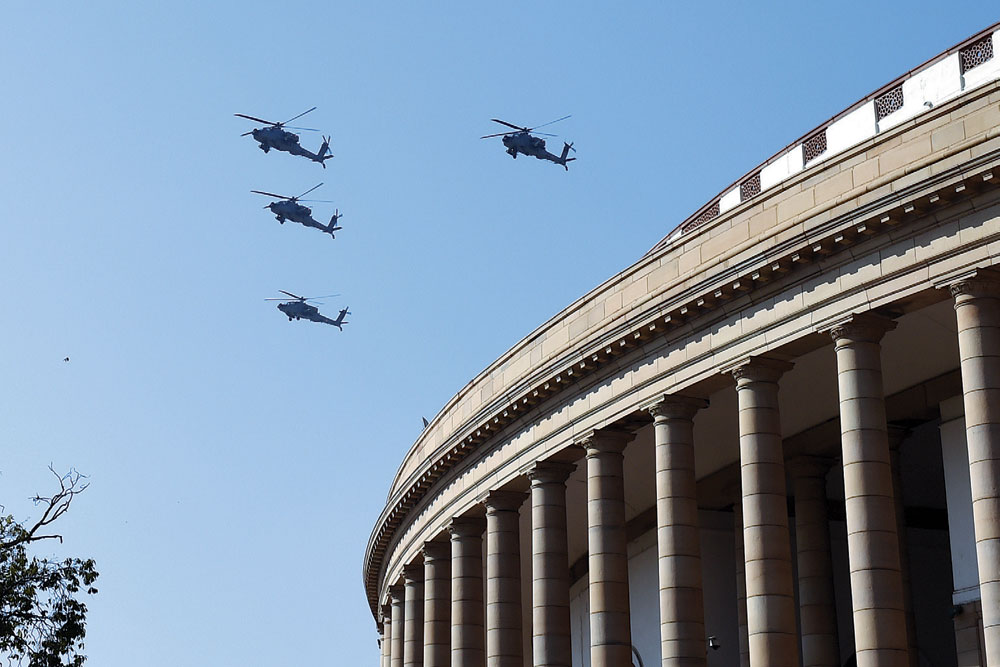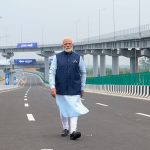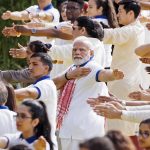What’s the Deal?
It is in India’s interest to heed America’s desire for a larger trade pact
 Ullekh NP and Siddharth Singh
Ullekh NP and Siddharth Singh
 Ullekh NP and Siddharth Singh
|
21 Feb, 2020
Ullekh NP and Siddharth Singh
|
21 Feb, 2020
/wp-content/uploads/2020/02/TheDeal1.jpg)
(Illustration: Saurabh Singh)
IN 1994, PRIME Minister PV Narasimha Rao and US President Bill Clinton met in Washington DC in what was dubbed an ice-breaking moment between the two countries. Among a host of issues discussed was one curious item: a trade dispute over almonds.
A quarter century later, fighting over almonds continues between the two countries that have seen a sea change in their ties. From the frost during the Cold War to a ‘strategic partnership’, there has been an overhaul of the bilateral relationship. Last year, the US pipped China as India’s top trading partner by a small margin of about $14 million. The monetary value was small but its symbolic import was huge. Who could have imagined two decades ago, when the actual thaw began, that India would one day buy crude oil from the US? The idea that the US would sell key defence equipment to New Delhi was more in the realm of fantasy.
Yet, even with the vast improvement in bilateral ties, there is always some friction between the two countries. Ever since Donald Trump assumed the American presidency, the two countries have regularly sparred over trade and economic matters. Disputes over price controls on medical devices, India’s price controls on coronary stents and knee implants, retaliatory tariffs on almonds, cashews, walnuts, apples and other agricultural items have irked the US. That’s not all. Trump has called India the “tariff king” of the world. At a broader level, the US, especially Trump, has complained about the trade deficit in India’s favour. It is another matter that at roughly $25 billion, the US’ trade deficit with India in 2019 was much smaller than the $350 billion figure for China. Then there are issues over investment limits imposed by India’s Foreign Direct Investment (FDI) regime. In key sectors like insurance and media, among others, there are significant barriers even after the liberalisation of FDI by India.
Then there are minor but hugely symbolic cases such as tariffs on Harley Davidson motorcycles. On top-end versions of the bike, there are tariffs of up to 50 per cent imposed by India. For someone like Trump, that rankles. The two countries have never come anywhere close to a free trade agreement. The much touted ‘trade deal’ in the news for a while is likely to involve minor concessions by the two sides. With the US trade representative, Robert Lighthizer declining to visit India, even that small deal seems remote now. Behind the scenes, there were allegations that the US was shifting ‘goalposts’ and, on the American side, that India was playing ‘hardball’.
If the overall pattern of trade leaves the two sides dissatisfied, there is another kind of trade—defence—that is robust and is the sweet spot of bilateral ties
Alyssa Ayres, former Deputy Assistant Secretary of State for South Asia in the Obama administration, who is now with the Council on Foreign Relations, has written extensively on this subject. She tells Open, “I can’t remember a time when US-India trade ties weren’t hard. We have significant and ongoing disagreements over many things; India is still a more closed economy with barriers that Indian leaders see as crucial to protect Indian industry. So, to the extent that US-India ties have improved over the last 20 years (I would date this really to the Clinton visit in 2000, with the Bush administration a quantum leap after that), the trade piece has long been tough. Despite the tensions on the government-to-government side, bilateral trade volumes have grown significantly, from $16 billion in 1999 to 2018’s $142 billion. That is encouraging and suggests that this growth could boom further if some of the constraints on both sides (I believe there are more constraints in India) were removed.”
She adds that one of the hurdles is that India continues to protect industries it sees as unable to compete on a level-playing field. India withdrew from the Regional Comprehensive Economic Partnership (RCEP), which would have required it to end tariffs with ASEAN countries on almost all goods. RCEP negotiations hinged on a concern that cheap Chinese goods would flood the market and harm Indian producers. Ayres adds: “I don’t entirely understand this framework—it seems like global shifts currently provide a major opening for Indian growers and producers and manufacturers, provided needed reforms are put in place, to make inroads across other global markets. Especially with manufacturing production shifting out of China as wages rise there. The main beneficiary of this shift has so far been Vietnam. India has a window to open on this front.”
For his part, Michael Kugelman, Deputy Director of the Asia Program and Senior Associate for South Asia at the Wilson Center, agrees that bilateral trade constraints are a consequence of stubborn protectionist impulses on both sides. “These impulses have become stronger in this global era of populism, which has produced two leaders, Trump and Modi, who are both close to the business sector but hesitant to fully open up to the world commercially. Each leader knows that he has important constituencies that won’t take well to more free trade. While I do think that things could improve eventually, I imagine these obstacles to greater trade relations won’t get much better in the near term,” he tells Open. And that’s because there are powerful factors in both countries that will give the two leaders pause, he reasons, emphasising that “it’s an election year in America, and Trump will want to be cautious about pushing for outcomes that could be perceived as imperilling jobs. And with Modi experiencing an economic slowdown and a jobs crisis, he’ll need to be careful as well.”
Like Ayres, Pravin Krishna of Johns Hopkins University has closely followed the disagreements over trade between India and the US. He says they are inevitable in the context of any economic relationship between countries. The Trump administration has (perhaps more than others before) been willing to set aside geopolitical calculations in pursuing its trade goals, he argues. “They have targeted both allies (Canada, Japan, the European Union) and rivals (China). Some acrimony in trade relations or negotiations is not unusual. On the positive side: the trade relationship with India is still relatively small (and so does not present itself as an important platform for action or political posturing from the US perspective). On the other hand, the protectionist backslide and increasing calls for ‘import substitution’ in India have not gone unnoticed in Washington and may narrow the room for compromise. Let us see where the current negotiations end up,” Krishna explains.

Krishna adds that the US does indeed seek expanded access to India’s market—in agriculture and in other sectors where it has exporting strengths. “Likewise, India will and should seek expanded access to its partners’ markets. This is what trade negotiations are all about. It is definitely not unusual,” he tells Open.
All of this is happening, in fact, against the backdrop of a surge in trade between the two countries over the years. In 2018, trade in goods and services touched $142 billion from a very low base of around $20-25 billion at the turn of the century.
IF THE OVERALL PATTERN of trade leaves the two sides dissatisfied, there is another kind of trade that is robust and has gone guns blazing in the last decade. Kugelman is excited about it. He says that it is certainly true that while trade ties are the Achilles Heel, defence ties are the sweet spot of the relationship. “And that’s likely how it will remain for quite some time. That said, I think we could see some modest improvements on the trade front down the road, and for several reasons. First, when the two sides conclude their trade deal, the one that Trump will want to sign when he’s in India, that will provide some momentum and confidence-building ammunition for the future, as limited as the trade accord is bound to be. Second, there’s been sustained high-level dialogue on the trade front for quite some time, and something has to give. Even if the two sides have struggled to make major progress, the sustained discussions have built enough goodwill and trust on the commercial front to allow for some forward movement down the road,” he explains.
Increasingly, the US is India’s preferred partner for high-end weapons systems. In this, it is replacing Russia, the country that has been the mainstay of India’s military needs since 1947. In the decade from 2007 to 2018, the US has sold close to $18 billion worth of equipment to India. If a major naval contract, one that was approved in late-2019, is signed, this figure will swell by another billion dollars. Heavy lift military transport aircraft (C-130J), maritime reconnaissance aircraft (P-81), attack helicopters (Apache AH-64-E) and a host of other systems are now routinely procured from the US.
Just weeks before Trump’s visit, the US State Department cleared a $1.9 billion sale for an Integrated Air Defence Weapon System (IADWS), a clutch of sophisticated radars and missiles that together form a ‘defence shield’ over a particular territory. This is meant for the Delhi area. Although the sale is yet to fructify into a contract, it represents an interesting choice for India. Earlier, India had signed a deal for the S-400 missile system that forms a similar shield with Russia. The trouble is that the Russian platform is reportedly running behind schedule while the American one is expensive. But there are other sweeteners that may materialise during Trump’s visit. It is possible that India may move forward on the purchase of 24 multirole helicopters (MH-24 Seahawk), valued at $2.6 billion, and a follow up order of six Apache helicopters for the Army.
In 2018, the US gave India a Strategic Trade Authorization Tier 1 status that allowed India to access weapon systems and dual-use technologies denied to it earlier. Twenty years earlier, this was scarcely imaginable. India had tested nuclear devices and had been sanctioned by the US. The sea change in the political-military relationship since then has to rank among the major strategic shifts of the 21st century.
It is reasonable to ask whether friction over almonds, fancy motorcycles and apples is worth risking the most important relationship that India has at the moment
Much of this progress has been smooth and has been informed by the mutual need for each other in Asia. Although, to be realistic, India’s needs for American help far outdo what the US needs or has got from India for that matter. All this is informed by the big rhino in the room: China.
India and the US have carried out military exercises with minor breaks since 1992 in different formats. The Yudh Abhyas series of exercises have had 15 iterations until last year. The Malabar series of naval exercise began on a bilateral footing way back in 1992. By 2015, it had Japan as the third partner. Finally, the Quadrilateral Security Dialogue, known informally as the ‘quad’, began life in 2007 on the initiative of Japan’s Prime Minister Shinzo Abe, involved the four major Indo-Pacific powers: India, Japan, Australia and the US. The quad has had a chequered life as two members, India and Australia, hesitated before taking a leap. By 2015, all the four member states of the forum realised the acute danger from China. India overcame its fears of antagonising China by wholeheartedly joining the quad after the military threat from China turned malignant.
While all these mechanisms and institutional developments have been built up over time, India continued to display caution until the second Narendra Modi Government. Since then, some of the hesitations have further eroded even as the global situation has become more complex. As President Trump comes to India, three things stand out. One, as a politician, Trump’s base is among people who have been ‘left behind’ by the last wave of globalisation so to speak. As a result, trade, management of trade deficits and, in general, ‘getting a good deal’ matter to him much more than any other president in recent memory. Two, India is complacent at the moment and does not see the danger of a rising China to the degree it should. China is now within striking distance of catching up economically and militarily with the US. That date may seem distant but it is not more than a decade or so. In this period, the danger of a military situation turning into something for the worse cannot be ruled out. China is likely to get more aggressive by every year even as India’s weak economic growth leaves its military modernisation plans in tatters. This fiscal (2020-21), the expenditure on pensions for armed forces veterans will exceed that on salaries of serving officers for the first time. The situation is so bad that the first Chief of Defence Staff (CDS), General Bipin Rawat, hinted at the shelving of the third aircraft carrier for the Navy and talked of acquiring key military platforms, including the badly needed fighter aircraft for the starved Air Force, in a staggered manner over time.
Finally, since 2015, the world is increasingly a place where nationalism and national boundaries matter as never seen in the last 25 years. India and the US are not immune to the trend.
In this complicated time, it is important both for India and the US to keep their alliance intact. It is important for India to heed the American desire for a trade deal and do as much as possible. It is reasonable to ask whether friction over almonds, fancy motorcycles and apples is worth risking the most important relationship that India has at the moment. In the months since the abrogation of Article 370 and communications restrictions in Jammu and Kashmir, the US has displayed patience and has backed India in the face of China’s aggressive moves at international forums. At another time, the Soviet Union fulfilled this diplomatic-cum-strategic role.
This has been despite a rising chorus of voices in the US Congress and other legislatures across the West where India has come in for sharp criticism. India does not have to feel beholden to the US but it certainly has to calculate its interests more carefully. There is an army of people, in India and the US, who would like the relationship to head south. It is well-known who these people are. India should not give them a chance. For its own sake.

/wp-content/uploads/2025/09/Cover-Modi-scaled.jpg)












More Columns
I Missed A Flight Thanks To Robert Redford, Plus He Took My Magazine! Alan Moore
Robert Redford (1936-2025): Hollywood's Golden Boy Kaveree Bamzai
Surya and Co. keep Pakistan at arm’s length in Dubai Rajeev Deshpande